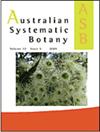Philotheca教派的系统发育、分类和生物地理学。基于nrDNA序列的芸香属
IF 1.6
3区 生物学
Q4 EVOLUTIONARY BIOLOGY
引用次数: 2
摘要
【摘要】灰蕨属(Erionema)包括来自澳大利亚东部的14种和澳大利亚西南部的1种。我们利用核糖体DNA ITS和ETS区域的序列,对所有物种的样本进行了系统发育分析。结果与先前基于形态学和类黄酮数据的分析大致一致。分析结果与剖面的单系性一致,支持多样本所代表的6个物种的单系性。疣藻(A. Rich)保罗·g·威尔逊(Paul G. Wilson)被认为是与P. freyciana rozefeld有关的精神病患者,但支持度很低。玻璃水蛭,肌孔水蛭和肌孔水蛭亚种。肌孔虫具有明显的多系性,包括独立的地理分支,每个分类群的分类都需要修订。其中,北方不相交的glass shousiensis居群可能代表了一个独立的种,myoporoides的5个亚种可能被视为独立的种,而目前至少有两个不同的类群被包括在亚种的范围内。肌孔虫可作为种处理。系统发育揭示了在澳大利亚东部存在的深度分化的、地理上重叠的分支,以及姐妹分类群之间的相当大的距离(高达900公里)。我们推断,该类群的生物地理在很大程度上是由分类群的变异分化形成的。本文章由计算机程序翻译,如有差异,请以英文原文为准。
Phylogeny, classification and biogeography of Philotheca sect. Erionema (Rutaceae) based on nrDNA sequences
ABSTRACT Philotheca sect. Erionema includes 14 species from eastern Australia and one from south-western Australia. We conducted a phylogenetic analysis of the section, including samples of all species, using sequences of the ITS and ETS regions of nuclear ribosomal DNA. Results were broadly congruent with a previous analysis based on morphological and flavonoid data. The analysis is consistent with the monophyly of the section and supports the monophyly of six species represented by multiple samples. Philotheca verrucosa (A. Rich.) Paul G. Wilson was resolved as paraphyletic with respect to P. freyciana Rozefelds but with poor support. Philotheca glasshousiensis, P. myoporoides and P. myoporoides subsp. myoporoides were clearly polyphyletic, including separate geographic clades and the classification of each of these taxa requires revision. In particular, disjunct northern populations of P. glasshousiensis probably represent a distinct species, the five subspecies of P. myoporoides could be treated as separate species and at least two other distinct groups that are currently included under the circumscription of subsp. myoporoides could be treated as species. The phylogeny revealed deeply divergent, geographically overlapping clades in eastern Australia and substantial distances (up to 900 km) between sister taxa. We infer that biogeography of the group has been shaped largely by vicariant differentiation of taxa.
求助全文
通过发布文献求助,成功后即可免费获取论文全文。
去求助
来源期刊

Australian Systematic Botany
生物-进化生物学
CiteScore
3.10
自引率
12.50%
发文量
12
审稿时长
>12 weeks
期刊介绍:
Australian Systematic Botany is an international journal devoted to the systematics, taxonomy, and related aspects of biogeography and evolution of all algae, fungi and plants, including fossils. Descriptive taxonomic papers should normally constitute a comprehensive treatment of a group. Short papers on individual species and nomenclatural papers must contain significant new information of broader interest to be considered. The prestigious L.A.S. Johnson Review Series is published. Other review articles will also be considered. All papers are peer reviewed.
Australian Systematic Botany is published with the endorsement of the Commonwealth Scientific and Industrial Research Organisation (CSIRO) and the Australian Academy of Science.
 求助内容:
求助内容: 应助结果提醒方式:
应助结果提醒方式:


